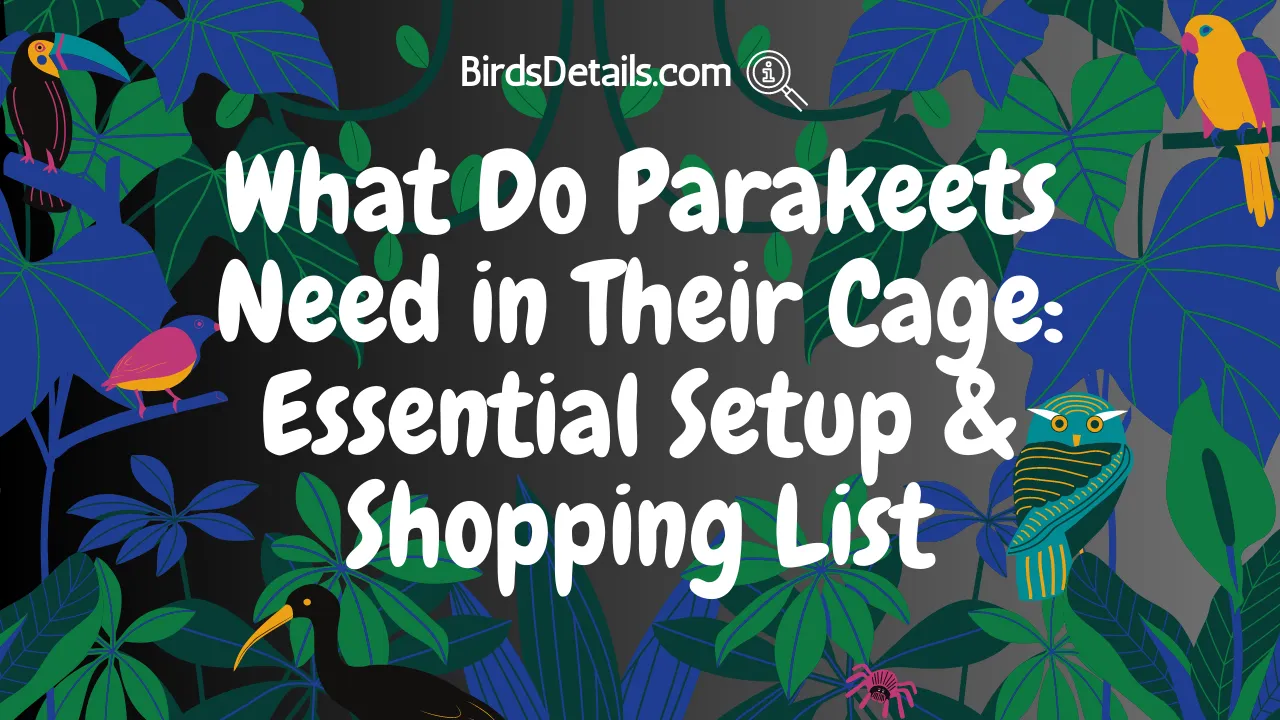Are you a proud owner of pet birds, specifically budgies? Do you want to ensure your new pet lives a happy and healthy life in your house? Well, let’s cut to the chase – providing a suitable cage for your budgies is crucial. Creating the perfect home for your little feathered friends goes beyond just having four walls and a perch. It’s about understanding what makes them tick, what they need to thrive, and how you can make their living space as comfortable as possible.
You might be wondering, why is it so important to get the budgie cage setup right. The answer lies in your new pet’s overall well-being. A proper cage setup contributes significantly to their happiness and health in your house. Just like humans, budgies need an environment that meets their physical and psychological needs.
Creating a comfortable habitat for your new budgie begins with understanding the significance of each element within the cage. From perches at varying heights for exercise and playtime to toys that stimulate their curious minds, every detail matters. By providing these essentials, you’re promoting mental stimulation, ensuring proper physical development, and reducing stress levels in your beloved pet. Make sure to cover the cage to create a safe and cozy environment for your budgies in your house.
| Item | Description |
|---|---|
| Cage | The cage should be at least 20 inches wide, 18 inches deep, and 24 inches high. It should have a variety of perches, including natural wood perches, and toys to keep your parakeet entertained. |
| Food and water dishes | The food and water dishes should be made of stainless steel or ceramic. They should be easy to clean and should be placed at the bottom of the cage. |
| Bathing dish | The bathing dish should be shallow and should be filled with lukewarm water. |
| Nesting box | If you plan on breeding your parakeets, you will need to provide them with a nesting box. The nesting box should be made of wood and should be about 12 inches wide, 10 inches deep, and 8 inches high. |
| Toys | Parakeets need toys to keep them entertained. There are many different types of toys available, so you can choose the ones that your parakeet will enjoy the most. Some popular toys include swings, ladders, and balls. |
| Vitamins and supplements | Parakeets need a balanced diet that includes vitamins and supplements. You can give your parakeet vitamins and supplements in their food or water. |
So, what exactly does an ideal budgie cage look like? In our upcoming discussion, we’ll delve into the various elements that make up this avian haven. We’ll explore appropriate sizing considerations (460px), suitable materials for construction, essential accessories such as food bowls and water dispensers, and even address potential safety concerns.
Get ready to transform your budgie’s house into a paradise tailored just for them! Let’s dive into the world of parakeet cage essentials together, including how to cover their house at night.
What Kind of Cage Does Your Parakeet Need?
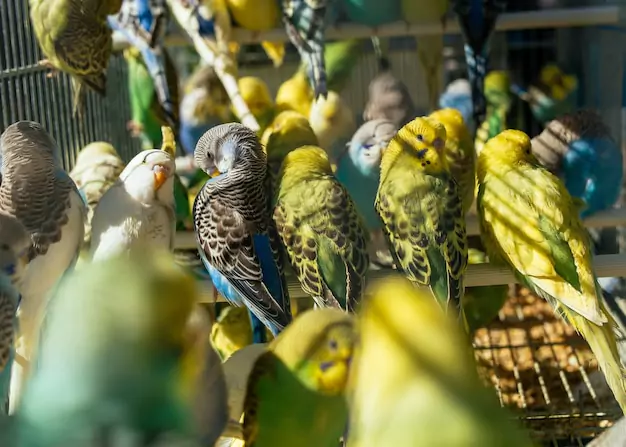
Different types of cages available for parakeets and their pros and cons
There are several options available for bird cages. Each type, including budgies and cage birds, has its advantages and disadvantages, so it’s important to consider what will work best for your new parakeet.
- Wire Cages: These are the most common type of parakeet cage you’ll find in pet stores. They are made of sturdy wire bars that allow for good ventilation and visibility. Wire cages also come with a removable tray at the bottom for easy cleaning. However, one thing to keep in mind is the bar spacing. Make sure the bars are close enough together to prevent your parakeet from squeezing through or getting stuck.
- Flight Cages: As the name suggests, flight cages are larger enclosures that provide ample space for your parakeet to fly around. They often have multiple perches and toys, allowing your bird to engage in natural behaviors like hopping and climbing. Flight cages can be a great option if you have enough room in your home and want to give your parakeet plenty of exercise opportunities.
- Acrylic Cages: Acrylic cages offer a clear view of your parakeet without any bars obstructing the view. This can be beneficial if you want an unobstructed view of your bird or if you have other pets that might try to reach through the bars. However, acrylic cages may not provide as much ventilation as wire or flight cages, so proper airflow should be ensured.
- Travel Cages: If you plan on taking your parakeet on trips or vet visits, a travel cage is essential. These smaller, lightweight cages are designed with portability in mind and often come with handles for easy carrying. They usually have secure latches to prevent any accidental escapes while on the go.
Factors to consider when choosing the right size for your parakeet’s cage
To ensure your budgie has enough space to move around comfortably in its house, it’s crucial to choose the right size cage cover. Here are some factors to consider when selecting a cage cover for your budgie house. Additionally, make sure you have the proper license for owning a budgie.
- Wingspan: Parakeets love to spread their wings and fly around. A good rule of thumb is to choose a cage that is at least twice the width of your parakeet’s wingspan. This will give them enough room to stretch their wings fully without hitting any sides.
- Vertical Space: Parakeets also enjoy climbing and perching at different heights. Opt for a cage that is tall enough for them to move up and down easily, with multiple perches placed at varying heights.
- Bar Spacing: As mentioned earlier, bar spacing is crucial in preventing escape or injury. For small parakeets, aim for a maximum bar spacing of ½ inch (1.27 cm). This will prevent them from getting stuck or squeezing through the bars.
- Interior Layout: Consider the layout of the cage as well. Ensure there is enough space for food and water dishes, toys, perches, and even a cozy sleeping area where your parakeet can retreat when they want some privacy.
Understanding the importance of bar spacing in preventing escape or injury
The bar spacing on your parakeet’s cage, including the house, is crucial for their safety and security. If the bars are too far apart, there is a risk of your bird escaping or getting injured in an attempt to squeeze through. Make sure the v4 bar spacing is appropriate for your parakeet’s size.
Parakeets are known for their curious nature and ability to fit through tight spaces due to their flexible bodies. Therefore, it’s crucial to select a cage with appropriate bar spacing that prevents any potential mishaps in the house.
When considering bar spacing for cage birds like parakeets in your house, keep in mind that baby parakeets may require narrower spacing initially, as they are smaller and more agile. As they grow, you can gradually increase the bar spacing to accommodate their size. This is especially important when choosing a v4 cage for your parakeets.
Regularly inspect the v4 cage for any signs of wear or damage that may affect the integrity of the bars. Loose or bent bars in the house should be addressed immediately to prevent any potential hazards.
Features to look for in a durable and safe cage for your feathered friend
When choosing a parakeet cage for your house, it’s important to prioritize durability and safety. Here are some features to look out for in a v4 parakeet cage.
Non-toxic Materials: Ensure that the cage is made from non-toxic materials, such as powder-coated metal or acrylic, as parakeets have a habit of nibbling on their surroundings.
Choosing the Right Cage: A Buyer’s Guide

Researching reputable brands known for quality bird cages
Choosing the right birdcage for your house is crucial. To ensure you make an informed decision, it is important to research reputable brands that are known for their quality v4 bird cages. Look for brands that have a strong reputation in the avian community and positive customer reviews.
Some well-known brands that offer high-quality v4 parakeet cages for your house include Prevue Hendryx, Vision, and Yaheetech. These v4 brands have been trusted by bird owners for years and are known for their durable construction, thoughtful design, and attention to detail.
Before purchasing cage birds, take the time to read product descriptions and customer feedback for the house. Look out for features such as sturdy construction, non-toxic materials, secure locks, and proper ventilation. By doing your homework and selecting from reputable brands like v4, you can ensure that your parakeet will have a safe and reliable home.
Factors to consider such as material, design, and ease of cleaning when purchasing a cage
When choosing a cage for your feathered friend, one of the most important factors to consider is the material. Stainless steel cages are highly recommended for their durability, easy cleaning, and resistance to rust or corrosion. They provide excellent visibility for both you and your parakeet in your house.
In terms of house design, opt for a cage with horizontal bars spaced appropriately so that your parakeet cannot squeeze through or get stuck between them. The size of the v4 cage is also crucial; it should be large enough to allow your parakeet to stretch its wings fully without any restrictions. A general rule of thumb is that the cage should be at least 2 feet wide by 2 feet tall.
When purchasing a parakeet cage for your house, ease of cleaning is a vital factor to consider. Look for cages with removable trays or grate bottoms to make cleaning the house a breeze. Cages with easy-access doors and feeding stations can save you time and effort in the house.
Budget-friendly options without compromising on safety or functionality
If you are on a tight budget and looking for a cost-effective option for a birdhouse, consider looking for used cages in good condition. Many bird owners upgrade their cages over time, so you may be able to find a quality house at a lower price that does not compromise on safety or functionality.
Another budget-friendly choice for parakeet owners is to consider purchasing a flight cage instead of a traditional parakeet cage. Flight cages are larger and provide more room for your parakeet to move around and exercise in the house. They often come with multiple perches and feeding stations, making them an excellent value for money.
When looking for an affordable house option, it’s important to prioritize safety over price. Ensure that the cage meets all the requirements for your parakeet’s well-being, such as appropriate bar spacing, secure locks, and non-toxic materials.
Tips on where to buy a suitable parakeet cage, both online and offline
You have various options both online and offline when it comes to finding the perfect house for your feathered friend. Here are some tips on where to find the perfect home for your bird.
- Visit local pet stores that specialize in bird supplies to find a wide selection of cages suitable for parakeets. These stores often have a variety of options for your house.
- Bird specialty stores are the best places to find high-quality bird cages for your house. Look for stores that specifically cater to birds and avian enthusiasts.
- Online retailers like Amazon or Chewy offer an extensive selection of bird cages for your house at different price points.
- Check out classified ads in your local newspaper or online platforms like Craigslist or Facebook Marketplace to find affordable used cages for sale. These platforms are great for finding individuals selling cages for your house.
- Attend bird shows or expos in your area where vendors often showcase a variety of bird-related products, including cages for your house.
Remember to compare prices, read customer reviews, and consider the reputation of the seller before purchasing your house. By exploring these options, you can find a suitable parakeet cage that meets your house’s requirements and budget.
Setting Up a Birdcage for Your Parakeet or Cockatiel
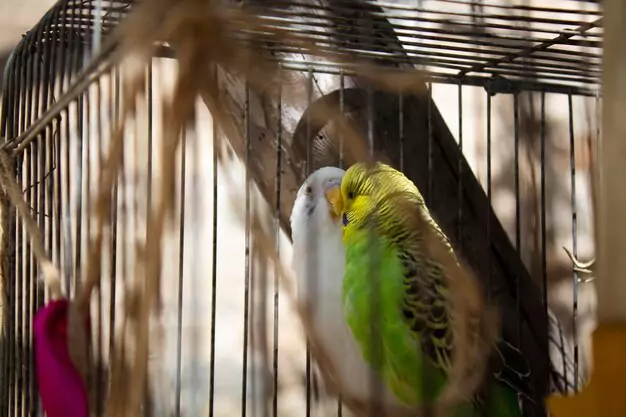
Importance of Selecting an Appropriate Location within Your Home for the Birdcage
Choosing the right location for your bird’s house is crucial to their overall well-being and happiness. Birds are highly social creatures, so it’s important to place their house in an area where they can feel like part of the family while still having their own space. Consider placing the house in a room where your family spends most of their time, such as the living room or kitchen.
By placing the birdcage in a central location, you allow your parakeet or cockatiel to observe and interact with you and other household members throughout the day. This social interaction is essential for their mental stimulation and emotional health. Being near human activity helps prevent feelings of isolation that can lead to boredom or even depression in birds.
Another factor to consider when choosing a location for your house is noise level. Birds have sensitive hearing, so it’s best to avoid areas with excessive noise or sudden loud sounds. Avoid placing the birdcage near televisions, stereos, or busy hallways where there may be constant commotion. Instead, opt for a quieter spot where your feathered friend can find peace and tranquility in your house.
Ensuring Proper Ventilation in the Chosen Area
Proper ventilation is vital for maintaining good air quality within your bird’s house. Stale air can lead to respiratory problems and other health issues in birds. When selecting a location for the birdcage, ensure that there is adequate airflow in that area of the house.
Avoid placing the bird cage near drafts or direct airflow from air conditioning vents in your house as this can harm your pet bird’s health due to temperature fluctuations. However, make sure not to place them in a poorly ventilated area of your house.
To ensure sufficient fresh air circulation in your house without exposing your bird directly to drafts, you can position the cage a few feet away from windows or doors. This way, your feathered friend can enjoy natural light and fresh air in your house without being exposed to direct drafts that could potentially cause harm.
Considerations Regarding Temperature Fluctuations and Avoiding Direct Sunlight Exposure
Birds are highly sensitive to temperature changes, so it’s crucial to keep their house in an area where they won’t be subjected to extreme temperatures. Avoid placing the birdhouse near heating or cooling sources, such as radiators or air conditioning units.
Direct sunlight exposure can also be harmful to birds in the house. While they need natural light for their overall well-being, prolonged exposure to direct sunlight can cause overheating and discomfort. Place the bird cage in an area where it receives ambient light but is not directly in the path of intense sunlight.
If your house tends to get too hot or cold during certain seasons, consider using additional measures to regulate the temperature around the birdcage. For example, during colder months, you can use a bird-safe heat lamp or provide extra bedding material for insulation. Conversely, during hotter months, ensure proper airflow in your house and consider using shades or curtains to block excessive sunlight.
Precautions When Setting Up the Birdcage if You Have Other Pets Around
If you have other pets in your house, it’s essential to take precautions when setting up the birdcage to ensure the safety of both your parakeet or cockatiel and your other furry companions.
For dogs and cats specifically, make sure there is no way they can access the birdcage physically in the house. Birds are vulnerable creatures with delicate wings that should never be exposed to potential predators like cats or dogs in the house. Consider placing the cage on a stand that is high enough so that it remains out of reach for curious paws in the house.
It’s also important to supervise interactions between your pets and birds closely in the house. Even if you trust your dog or cat around smaller animals in the house, accidents can happen. Always keep an eye on their behavior in the house and separate them if you notice any signs of aggression or excessive interest in the house.
To create a safe environment for your bird in your house, ensure that the cage bars are appropriately spaced to prevent other pets from reaching inside. Consider using coop cups or dishes that securely attach to the side of the cage for food and water, preventing other animals from accessing them.
By taking these precautions, you can provide a secure and comfortable living space for your parakeet or cockatiel while ensuring harmony among all your pets in the house.
Step-by-step Guide to Cage Setup

Assembling the different parts of the birdcage correctly
Setting up a birdcage for your parakeet house is an important task that requires careful consideration. To ensure your feathered friend feels safe and comfortable in their house, it’s crucial to assemble the different parts of the birdcage correctly. Start by gathering all the necessary components for the house, including the cage itself, perches, food dishes, water dispensers, and any additional accessories you plan to include.
Begin by carefully following the manufacturer’s instructions to assemble the house cage. Make sure all panels are securely connected and that there are no loose or sharp edges that could potentially harm your parakeet. Double-check that the doors open and close smoothly without any obstructions.
Placing essential items like perches, food dishes, and water dispensers
Once you have assembled the cage, it’s time to strategically place essential items inside. Parakeets require multiple perches at varying heights to exercise their feet and maintain their overall well-being. Position these perches diagonally across from each other to allow your parakeet ample room for movement.
Next, position food dishes in easily accessible locations within the cage. Consider placing them near one of the perches so that your parakeet can comfortably eat while perched. Ensure that food dishes are secured in place to prevent accidental spills or tipping over.
Water dispensers should also be placed within easy reach of your parakeet. It is recommended to use a water dispenser with a sipper tube or a small dish rather than an open container to minimize contamination risks. Regularly check and refill both food and water containers to ensure a constant supply for your pet.
Adding bedding material at the bottom of the cage
To provide comfort and cleanliness for your parakeet, adding bedding material at the bottom of its cage is essential. Opt for materials such as paper-based bedding or wood shavings that are safe for birds. Avoid using cedar or pine shavings as they can release harmful aromatic compounds.
Spread a layer of bedding material evenly across the cage floor, ensuring it is deep enough to absorb droppings and provide cushioning for your parakeet’s feet. Regularly monitor and replace soiled bedding to maintain a hygienic environment for your pet.
Incorporating toys and accessories to provide mental stimulation
Parakeets are intelligent and active birds that require mental stimulation to thrive. To keep your feathered friend entertained, incorporate a variety of toys and accessories into their cage setup. This will help prevent boredom and encourage natural behaviors such as climbing, chewing, and exploring.
Consider providing toys with different textures, shapes, and colors to cater to your parakeet’s preferences. Examples include hanging swings, bells, puzzle toys, and shreddable items made from bird-safe materials like wood or paper.
Rotate the toys regularly to keep things interesting for your parakeet. By introducing new toys periodically, you can ensure a continuous source of mental stimulation while preventing them from losing interest in their surroundings.
Essential Supplies for Parakeet Care
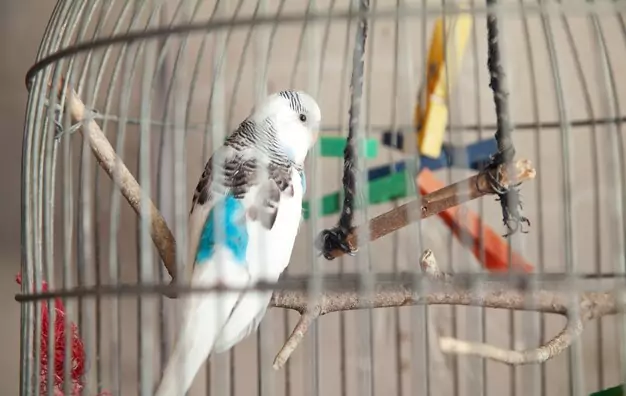
Fresh Food and Water: Keeping Your Parakeet Nourished
Your parakeet’s health and well-being depend on a balanced diet. Providing fresh food and water daily is crucial to meet their nutritional needs. These colorful little birds love variety, so make sure to offer them a diverse range of foods. A good base diet consists of high-quality parakeet pellets, which are specially formulated to provide essential nutrients. You can also supplement their diet with fresh fruits and vegetables such as apples, carrots, spinach, and bell peppers.
In addition to the main staples, it’s important to include some treats suitable for parakeets. These treats not only add excitement to their meals but also provide additional nutrients. Millet sprays are a popular choice among parakeets as they love pecking at the seeds. You can hang millet sprays in the cage or hold them by hand as an interactive treat option.
Cleanliness Is Key: Regularly Cleaning and Replacing Bedding Material
Maintaining cleanliness in your parakeet’s cage is essential for their overall health and hygiene. Regularly cleaning the cage helps prevent the buildup of bacteria and keeps your feathered friend comfortable. The bedding material should be replaced at least once a week or more frequently if it becomes soiled.
When choosing bedding material for your parakeet’s cage, opt for something safe and non-toxic like paper-based products or hardwood shavings. Avoid using cedar or pine shavings as they can release harmful chemicals that may affect your bird’s respiratory system.
Cleaning the entire cage involves several steps. Start by removing any uneaten food, droppings, or feathers from the bottom of the cage using a small handheld vacuum or dustpan and brush specifically designated for this purpose. Next, wipe down all surfaces with a mild bird-safe disinfectant solution diluted according to manufacturer instructions. Rinse thoroughly to remove any residue, and allow the cage to air dry completely before adding fresh bedding material.
Be Prepared for Emergencies: Having a First Aid Kit Handy
Accidents happen, even to our feathered friends. That’s why it’s important to have a well-stocked first aid kit specifically designed for birds. This way, you can quickly respond to any minor injuries or health issues that may arise.
Your parakeet’s first aid kit should include essential items such as styptic powder (to stop bleeding from minor cuts or broken feathers), antiseptic solution (for cleaning wounds), saline solution (for flushing eyes), and a pair of blunt-end scissors (for trimming feathers if necessary). It’s also wise to have an avian vet’s contact information readily available in case of emergencies beyond your expertise.
Remember, while having a first aid kit is helpful, it does not replace professional veterinary care. If your parakeet experiences a serious injury or illness, it is crucial to seek immediate medical attention from an avian veterinarian.
Creating a Comfortable Environment in Your Parakeet’s Cage
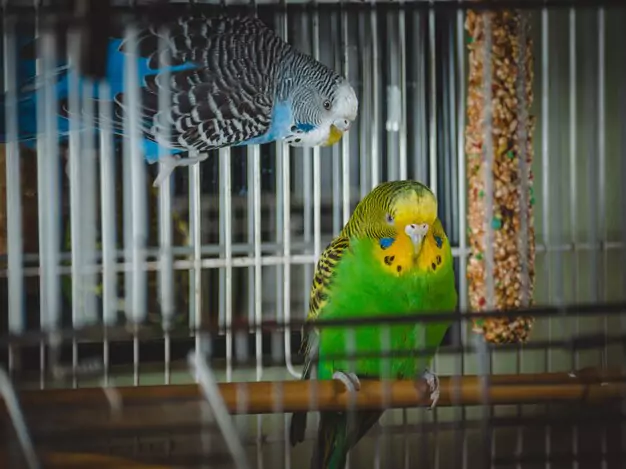
Choosing the Perfect Perches for Your Feathered Friend
One of the most important factors to consider is the selection of appropriate perches. Parakeets spend a significant amount of time on their feet, so providing them with comfortable and engaging perching options is crucial for their well-being.
To ensure your parakeet has enough room to move around and exercise its wings, choose perches of varying sizes and textures. Opt for natural wood branches that mimic their natural environment. These branches not only provide a sturdy surface for your parakeet to perch on but also offer an opportunity for them to engage in natural behaviors like chewing and climbing.
In addition to wooden perches, consider including other materials such as ropes or even ladders in the cage. These additions can provide different levels and surfaces for your parakeet to explore. By offering a variety of perch options, you create an engaging environment that keeps your feathered friend entertained throughout the day.
Cozy Nesting Spots: A Must-Have for Restful Sleep
Just like humans, parakeets need a cozy spot where they can rest and sleep peacefully. Providing suitable nesting spots within their cage is essential for their comfort and well-being. Consider adding small enclosed spaces or cozy huts where your parakeet can retreat when it wants some alone time or needs a good night’s sleep.
You can find various commercially available nesting boxes designed specifically for parakeets, but you can also get creative by using natural materials found in nature. For instance, you could place dried grass or straw inside a small basket or even use coconut shells as makeshift nests. The key is to create a safe and snug area where your parakeet feels secure.
Remember to position these nesting spots at different heights within the cage so that your parakeet can choose the one that suits its mood or preference. By providing cozy nesting spots, you ensure that your parakeet has a peaceful retreat whenever it needs some downtime.
Natural Materials: Bringing the Outdoors In
Incorporating natural materials into your parakeet’s cage can significantly enhance its comfort and well-being. Parakeets are naturally drawn to branches and twigs, so including these elements in their cage will help them feel more at home.
Look for non-toxic branches of varying thicknesses to provide perches and chewing opportunities for your feathered friend. These branches not only add visual interest to the cage but also serve as a way for your parakeet to exercise its beak and maintain a healthy beak structure.
Consider adding ropes made from safe materials like cotton or hemp. These ropes can serve as both perches and playthings for your parakeet. They offer a different texture and encourage physical activity as your bird hops along them or engages in acrobatic maneuvers.
By incorporating natural materials into your parakeet’s cage, you create an environment that closely resembles its natural habitat, promoting overall well-being and contentment.
Spaciousness: The Key to Happy Wing Stretching
Parakeets are active birds that require ample space within their cages to move around freely and stretch their wings. When selecting a cage, prioritize size over aesthetics. Choose a roomy enclosure that allows your parakeet to fly short distances within it comfortably.
Ensure there is enough floor area for your bird to hop around without feeling cramped. A crowded cage can lead to stress and even health issues over time. Make sure the height of the cage allows sufficient room for vertical movement, enabling your parakeet to climb up or down as it pleases.
Having enough space not only promotes physical health but also encourages mental stimulation through exploration and play. Remember that in the wild, parakeets have vast areas to roam, so providing a spacious cage is the closest we can get to replicating their natural habitat.
Enrichment Ideas for a Stimulating Cage
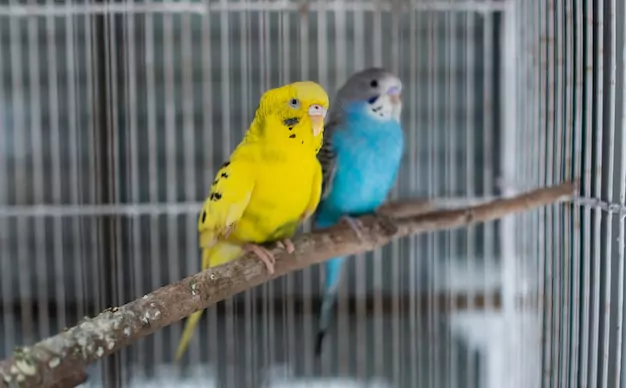
Incorporating Interactive Toys that Encourage Mental Stimulation and Physical Activity
Who says parakeets can’t have fun in their cages? To keep your feathered friend entertained, it’s essential to provide them with interactive toys that stimulate their minds and bodies. These toys come in various shapes and sizes, catering to different play styles and preferences.
One idea is to hang colorful ropes or ladders inside the cage. Parakeets love climbing, so these additions will give them a chance to flex their wings and show off their acrobatic skills. You can also attach small bells or beads to the ropes for an extra element of excitement.
Another great option is a puzzle feeder or foraging toy. These clever contraptions require your parakeet to solve puzzles or work for their food, mimicking their instincts in the wild. Fill these toys with treats or seeds, and watch as your bird figures out how to retrieve them. It’s like a game of hide-and-seek that keeps them engaged and mentally sharp.
Rotating Toys Regularly to Prevent Boredom
Just like humans, parakeets can get bored easily if they’re stuck with the same old toys day after day. To keep things interesting, make sure you rotate their toys regularly. This simple act of changing up the environment adds variety and prevents monotony.
Consider having a selection of toys on hand that you can swap out every few weeks. This way, your parakeet will always have something new to explore and play with. You’ll be amazed at how much joy they derive from discovering unfamiliar objects in their cage.
To make toy rotation even more exciting, introduce different textures into the mix. For example, include toys made from different materials such as wood, plastic, or metal. This diversity not only keeps things fresh but also allows your parakeet to experience different sensations while playing.
Introducing Puzzle Feeders or Foraging Toys to Stimulate Natural Instincts
Parakeets are natural foragers, spending hours in the wild searching for food. By introducing puzzle feeders or foraging toys into their cage, you can tap into this instinct and provide them with mental stimulation.
Puzzle feeders are designed to make your parakeet work for their meals. These toys often have hidden compartments or obstacles that require problem-solving skills to access the food inside. As your bird learns how to navigate these challenges, they’ll feel a sense of accomplishment and satisfaction.
Foraging toys take things a step further by mimicking the experience of finding food in nature. These toys usually consist of small compartments or tubes where you can hide treats or seeds. Your parakeet will have a blast exploring, pecking, and reaching into these crevices to retrieve their rewards.
Providing Opportunities for Social Interaction
Parakeets are social creatures and thrive on companionship. While they may enjoy your company as their human caregiver, it’s also important to give them opportunities for social interaction within their cage.
One way to achieve this is by placing a mirror inside the cage. Parakeets are naturally curious birds, and when they see their reflection, they often perceive it as another bird. This can lead to amusing interactions as they try to communicate with their newfound “friend.”
If you’re looking for something more dynamic than a mirror, consider getting a companion bird for your parakeet. Having another feathered friend in the same cage allows them to engage in social behaviors like preening each other’s feathers or chirping together. Just make sure you introduce new birds slowly and monitor their interactions closely.
Must-Have Items for Your Parakeet’s Well-being
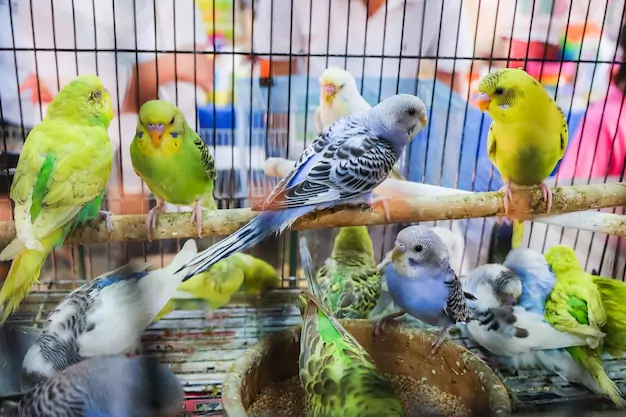
Perches: Keeping Those Little Feet Healthy and Active
Parakeets spend a significant amount of time on their feet, so it’s crucial to provide them with a variety of perches in their cage. These perches not only serve as resting spots but also promote foot health and exercise. Opt for different types of perches made from natural materials such as wood or rope to give your feathered friend some texture to grip onto.
Having a range of perch sizes is important too. This will help prevent foot problems like bumblefoot, which can occur when birds constantly grip narrow or uncomfortable surfaces. Make sure the perches are wide enough for your parakeet to comfortably stand on without straining its feet.
Nutritious Birdseed Mix: A Balanced Diet in Every Bite
Feeding your parakeet a nutritious birdseed mix is essential for its overall well-being. Look for a high-quality blend that contains essential vitamins and minerals to support your pet’s health. The mix should include seeds like millet, canary grass seed, and sunflower seeds.
While birdseed is an important part of their diet, it shouldn’t be the sole source of nutrition. Parakeets also need fresh fruits, vegetables, and pellets specially formulated for their dietary requirements. Including these foods alongside the birdseed mix ensures that your parakeet receives a balanced diet packed with all the necessary nutrients.
Cuttlebone or Mineral Block: Promoting Beak Health and Calcium Intake
Parakeets’ beaks continuously grow throughout their lives, so providing them with suitable items to chew on is vital. One must-have item in their cage is a cuttlebone or mineral block. These calcium-rich supplements not only keep your parakeet’s beak trimmed but also fulfill its need for calcium intake.
Attach the cuttlebone or mineral block securely to the side of the cage, ensuring easy access for your parakeet. This way, it can chew on it whenever it feels the need. Regularly check and replace these items as needed to ensure they remain fresh and effective.
Safe Chew Toys: Satisfying Your Parakeet’s Natural Urge to Gnaw
Parakeets have an instinct to gnaw on objects, which helps keep their beaks in good condition. Providing safe chew toys in their cage is an excellent way to satisfy this urge while keeping them entertained. Look for toys made from bird-safe materials such as untreated wood or vegetable-based dyes.
Toys with different textures and shapes will keep your parakeet engaged and mentally stimulated. Consider options like hanging toys, puzzle toys, or even shreddable toys that mimic natural foraging behavior. Regularly rotate the toys in their cage to keep things interesting and prevent boredom.
Things to Put in Your Parakeet’s Cage

Fresh fruits and vegetables as part of a balanced diet
Your parakeet’s cage should be filled with an assortment of fresh fruits and vegetables to ensure they receive a well-rounded diet. These colorful treats not only provide essential vitamins and minerals but also add variety to their meals, making them more enjoyable for your feathered friend.
Consider offering a range of options such as slices of apple, pear, or banana. Leafy greens like spinach or kale can also be included. Don’t forget to introduce some crunchy veggies like carrots or bell peppers, which will help keep your parakeet’s beak strong and healthy.
To make feeding easier, you can attach small clips or hooks inside the cage where you can hang pieces of fruit or skewers loaded with vegetables. This way, your parakeet can enjoy nibbling on these nutritious goodies whenever they please.
A shallow dish with clean water available at all times
Water is an absolute necessity for your parakeet’s well-being. Ensure that there is always a shallow dish filled with clean water within easy reach inside the cage. Parakeets have a habit of dipping their beaks into the water before drinking, so having a shallow dish allows them to do so comfortably.
Make sure to change the water daily to prevent any bacteria from developing. Consider using a water dispenser that attaches securely to the cage bars, ensuring that your playful parakeet won’t accidentally tip it over during their acrobatics.
Soft bedding material like paper or wood shavings
Creating a cozy environment for your parakeet includes providing suitable bedding material in their cage. Opt for soft materials such as paper or wood shavings that are safe for birds and don’t contain any harmful chemicals.
Line the bottom of the cage with about an inch-thick layer of bedding material. This will help absorb droppings and keep the cage clean for longer periods. Parakeets love to dig and burrow, so having soft bedding allows them to indulge in their natural behaviors.
Remember to change the bedding regularly to maintain cleanliness and prevent any unpleasant odors from developing. Your parakeet will appreciate a fresh and comfortable living space.
A comfortable sleeping hut or nest box
Just like humans, parakeets need a cozy spot to rest and sleep in. Providing a comfortable sleeping hut or nest box will give your feathered friend a sense of security and privacy when they want some downtime.
There are various options available in pet stores, ranging from small huts made of natural materials like wood or coconut fiber to fabric-based tents that can be hung inside the cage. Choose one that suits your parakeet’s preferences and make sure it is sized appropriately for them to comfortably enter and exit.
Place the sleeping hut in a quiet corner of the cage where your parakeet can retreat whenever it feels like taking a nap or getting some uninterrupted sleep at night. It’s essential to regularly clean the sleeping area as well, ensuring hygiene for your pet bird.
Maintaining a Clean and Healthy Cage: Best Practices
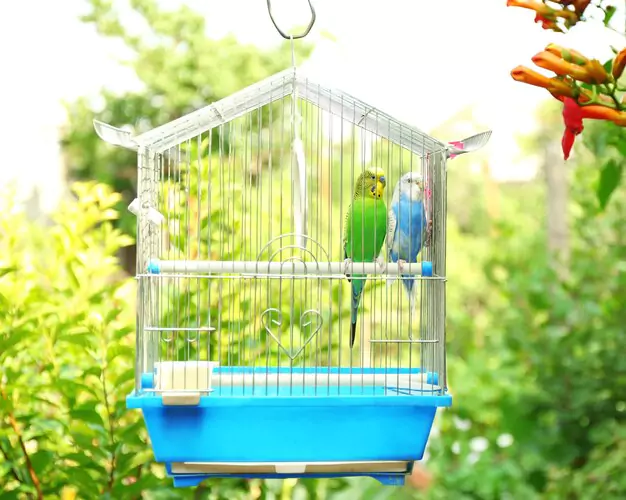
Regularly removing droppings from the cage bottom
Nobody likes living in a messy environment, and parakeets are no exception. To ensure your feathered friend stays happy and healthy, it’s important to regularly remove droppings from the bottom of their cage. This not only keeps the cage clean but also prevents any potential health issues that may arise from prolonged exposure to waste.
Cleaning up droppings can be as simple as using a small handheld vacuum or dustpan and brush. Make sure to dispose of the waste properly, as parakeet droppings can harbor harmful bacteria. By maintaining a clean cage bottom, you create a more hygienic living space for your pet.
Cleaning food dishes, water dispensers, and perches weekly
In addition to cleaning the cage bottom, it’s crucial to pay attention to other components within the cage that come into direct contact with your parakeet. Food dishes, water dispensers, and perches should be cleaned every week to prevent any buildup of bacteria or mold.
To clean these items effectively, start by rinsing them thoroughly with warm water. Use mild dish soap if necessary but make sure to rinse all soap residue off completely before returning them to the cage. This ensures that no harmful chemicals are ingested by your parakeet during mealtime or while perching.
Disinfecting the cage periodically using bird-safe cleaners
While regular cleaning is important for day-to-day maintenance, periodic disinfection of the entire cage is equally essential. Disinfecting helps eliminate any stubborn bacteria or viruses that may have accumulated over time.
When choosing a cleaner for your parakeet’s cage, opt for bird-safe products specifically designed for this purpose. Avoid using harsh chemicals or strong-smelling disinfectants that could irritate your pet’s respiratory system. Always follow the instructions provided by the manufacturer to ensure proper usage and safety.
Monitoring air quality within the cage by avoiding strong fumes or pollutants
Parakeets have delicate respiratory systems, making it crucial to monitor the air quality within their cage. Avoid exposing them to strong fumes, such as those from cleaning products, aerosols, or paints. These can be harmful and may lead to respiratory issues or other health complications.
Similarly, keep your parakeet’s cage away from areas with high levels of pollutants, such as cigarette smoke or kitchen exhaust. By ensuring a clean and well-ventilated environment for your pet, you minimize the risk of respiratory problems and help them maintain optimal health.
Ensuring a Happy Home for Your Parakeet
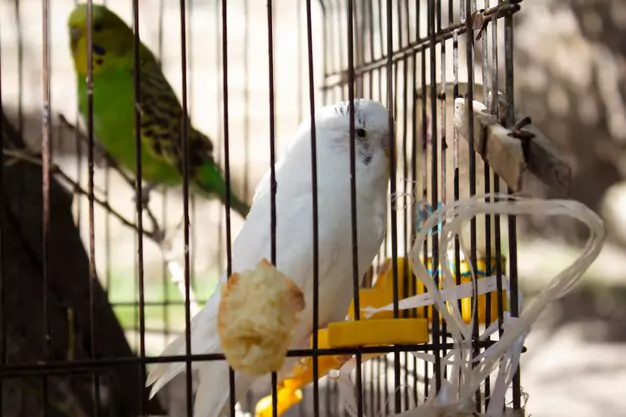
Owning a parakeet can be a delightful experience, but providing them with the right cage and environment is crucial for their well-being.
What Kind of Cage Does Your Parakeet Need?
Choosing the right cage is the first step in creating a happy home for your feathered friend. Opt for a spacious cage that allows your parakeet to stretch its wings and move around comfortably. Look for cages made of sturdy materials like stainless steel or wrought iron, as these are durable and easy to clean.
Choosing the Right Cage: A Buyer’s Guide
When purchasing a cage, there are several factors to keep in mind. Consider the bar spacing to ensure that your parakeet cannot escape or get stuck between the bars. Look for cages with multiple access doors for convenient cleaning and maintenance.
Setting Up a Birdcage for Your Parakeet or Cockatiel
Properly setting up your birdcage is essential to create a safe and comfortable living space. Provide perches of varying sizes and textures to promote foot health and exercise. Include toys and interactive elements to keep your parakeet mentally stimulated.
Step-by-step Guide to Cage Setup
To make sure you have everything covered during cage setup, follow this step-by-step guide:
- Start by thoroughly cleaning the cage using bird-safe cleaners.
- Line the bottom of the cage with appropriate bedding material.
- Place perches at different heights within the cage.
- Add food and water dishes in easily accessible locations.
- Introduce toys and enrichment items to keep your parakeet entertained.
Essential Supplies for Parakeet Care
Apart from the cage itself, there are several other supplies you’ll need to ensure proper care for your parakeet. These include high-quality bird food, fresh water, cuttlebone or mineral blocks for beak health, and a variety of toys to prevent boredom.
Creating a Comfortable Environment in Your Parakeet’s Cage
Make your parakeet feel at home by creating a comfortable environment within their cage. Provide soft bedding material for nesting and ensure the temperature is suitable for their well-being. Consider placing the cage away from drafts or direct sunlight.
Enrichment Ideas for a Stimulating Cage
To keep your parakeet mentally engaged, incorporate various enrichment ideas into their cage. Offer puzzle toys, hanging swings, and interactive feeders to encourage natural behaviors and prevent boredom.
Must-Have Items for Your Parakeet’s Well-being
Certain items are essential for maintaining your parakeet’s overall well-being. These include proper lighting to mimic natural day-night cycles, a birdbath or misting bottle for bathing, and an avian veterinarian on hand for regular check-ups.
Maintaining a Clean and Healthy Cage: Best Practices
Regular cleaning is vital to maintain a healthy environment for your parakeet. Clean food and water dishes daily, remove any soiled bedding promptly and thoroughly clean the entire cage at least once a week. This will help prevent the buildup of bacteria or harmful substances.
By following these guidelines and providing your parakeet with an enriching habitat, you can ensure they live happily in their cage while enjoying optimal physical and mental health.
FAQs
Q: How often should I clean my parakeet’s cage?
Keeping your parakeet’s cage clean is crucial to their well-being. It is recommended to clean the entire cage thoroughly at least once a week. You should clean food and water dishes daily to prevent bacterial growth.
Q: What type of toys should I provide in my parakeet’s cage?
Offer a variety of toys to keep your parakeet mentally stimulated. Opt for toys that encourage physical activity, such as swings or ladders, as well as puzzle toys that provide mental challenges.
Q: Can I use sandpaper perch covers in my parakeet’s cage?
It is best to avoid using sandpaper perch covers in your parakeet’s cage. These can cause irritation and abrasions on their feet. Instead, opt for natural wood perches of varying diameters to promote foot health.
Q: How do I know if my parakeet is comfortable in its cage?
Signs of a comfortable parakeet include relaxed body posture, active behavior, healthy appetite, and engaging with toys or enrichment items within the cage. They should have bright eyes and vibrant feathers.
Q: Should I cover my parakeet’s cage at night?
Covering your parakeet’s cage at night can create a sense of security and help them sleep better. Use a lightweight cover that allows for proper airflow while ensuring the room remains dark enough for restful sleep.
These FAQs address common concerns among parakeet owners and provide helpful answers to ensure you provide the best care possible for your feathered friend.
Are you a proud owner of pet birds, specifically budgies? Do you want to ensure your new pet lives a happy and healthy life in your house? Well, let’s cut to the chase – providing a suitable cage for your budgies is crucial. Creating the perfect home for your little feathered friends goes beyond just having four walls and a perch. It’s about understanding what makes them tick, what they need to thrive, and how you can make their living space as comfortable as possible.
You might be wondering, why is it so important to get the budgie cage setup right. The answer lies in your new pet’s overall well-being. A proper cage setup contributes significantly to their happiness and health in your house. Just like humans, budgies need an environment that meets their physical and psychological needs.
Creating a comfortable habitat for your new budgie begins with understanding the significance of each element within the cage. From perches at varying heights for exercise and playtime to toys that stimulate their curious minds, every detail matters. By providing these essentials, you’re promoting mental stimulation, ensuring proper physical development, and reducing stress levels in your beloved pet. Make sure to cover the cage to create a safe and cozy environment for your budgies in your house.
So, what exactly does an ideal budgie cage look like? In our upcoming discussion, we’ll delve into the various elements that make up this avian haven. We’ll explore appropriate sizing considerations (460px), suitable materials for construction, essential accessories such as food bowls and water dispensers, and even address potential safety concerns.
Get ready to transform your budgie’s house into a paradise tailored just for them! Let’s dive into the world of parakeet cage essentials together, including how to cover their house at night.
